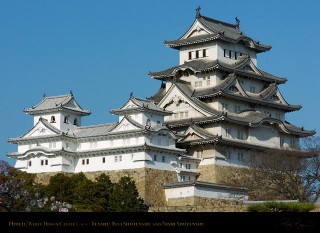Loading
Search
▼ 18 must-visit heritage sites in Japan (part 1)
- Category:World Heritage

Himeji Castle (Photo by : digital-image.net)
Visiting World Heritage Sites is a great way to see Japan. Since the sites are scattered all around the archipelago, you’re bound to be close to at least one of them no matter where you are in the country, and having gained the prestigious status by UNESCO, you can be sure you’re seeing the very best of Japan. After all, World Heritage status is not easily obtained and competition is stiff.
Join our peripatetic reporter as she takes you to each site and gives you the lowdown on what to see, how to avoid the crowds, and how to enjoy the sites on your own terms.
Although I have been to many of the World Heritage Sites myself, to learn the details on absolutely all of them I turned to the book Japan’s World Heritage Sites: Unique Culture, Unique Nature by John Dougill.
Here are Japan’s 18 World Heritage Sites :
1. Mount Fuji (Shizuoka Prefecture)
While Mount Fuji is famous the world over as a symbol of Japan, reports from many tourists who have climbed Japan’s highest mountain say they’re not sure they’d do it again. A combination of the popularity of Fujisan and the short climbing season means you’ll be ascending it along with hoards of others. The secret is that climbing Fuji is not the only way to experience it. Remember Hokusai’s Thirty Six Views of Mount Fuji? I chose to rent a car and drive around the Five Lakes region where I could admire the volcano at every turn. Fujisan was everywhere: looming over the horizon, reflected in the water, bathed in moonlight. Every morning we shared a cup of coffee from a campsite along the lake. There are many ways to see Mount Fuji without climbing it.
Travel Tip: If you are a Starbucks fan with a car, you can enjoy a morning Joe while gazing at the mountain at the Starbucks branch Tomei Highway rest area (Fujigawa Service Area Lower) in Shizuoka.
2. Itsukushima Shrine–Miyajima (Hiroshima Prefecture)
Although the view of Miyajima Island’s torii gate is great anytime, most people consider high tide the best time to photograph it, while it appears to be “floating.” In addition, water surrounds the Itsukushima shrine, covering up the mud flats you’ll see if you go at low tide. There are short boat tours out to the gate at high tide too.
Travel Tip: If you’re staying overnight on Miyajima, you’ll get the fantastic sunset and night views of the torii gate. However, Itsukushima shrine closes at 4 p.m. sharp and the whole town closes up at night.
3. The Peace Memorial-Genbaku Dome (Hiroshima Prefecture)
The Hiroshima Peace Park, Genbaku Dome, and the museum (all located within the park) are a must-see for all travelers. Be sure to leave enough time for the museum, where one is urged to reflect on the destructive nature of man.
Travel Tip: If you’re short on time, you can hit both Itsukushima Shrine and the Peace Memorial and museum in the same day, but only if you go to Miyajima first. Whereas Miyajima closes up at 4 p.m., the Peace museum is open until 6 p.m. giving you an extra two hours of sightseeing.
4. Himeji Castle (Hyogo Prefecture)
Himeji Castle is Japan’s largest, best preserved castles (as it was destroyed in wars, earthquakes or fires) and was one of Japan’s first World Heritage Sites. It boasts 4.8 km of walls and has recently reopened after years of renovation.
Travel Tip: Himeji is an easy stop on the Sanyo Shinkansen line. Tourist information office at JR Himeji Station.
5. Shirakawa-go and Gokayama (Gifu and Toyama prefectures)
These three villages of Shirakawa-go and Gokayama offer guesthouses, shops and restaurants amidst the iconic wooden sloped houses that were built to withstand heavy snowfall in this mountainous region of Japan. The shape of the houses also allowed for large living and working spaces so that families could use the bottom floors for cottage industries such as silk production, which required areas for silkworm beds and mulberry storage.
Travel Tip: The villages can be visited in one day by car.
6. Sites of Ancient Kyoto (Kyoto Prefecture)
Ancient Kyoto includes 17 sites, mostly temples and shrines. Among them is the Enryakuji temple complex on Mt. Hiei and home to the Marathon Monks which I’ve written about before, as well as some of Kyoto’s other well-known places of worship such as Kiyomizu-dera, Nijo Castle and The Golden Temple. But the one I’d like to highlight is Byodo-in Temple.
The Phoenix Hall of Byodo-in Buddhist temple was founded in 1052 and is said to be Japan’s most beautiful building. Although a very large building, one can unknowingly be schlepping around multiple replicas in their pocket on any given day because this building is featured on the back of the Japanese 10-yen coin. Byodo-in is located in Uji, a delightful little town to stroll around.
Travel Tip: There are a handful of ryokan alongside the river offering upscale Japanese-style accommodation. Try having your meals inside your room overlooking the river!
(source : japantoday.com)
- August 25, 2014
- Comment (2)
- Trackback(1)
Comment(s) Write comment
amoxicillin generic - <a href="https://combamoxi.com/">amoxicillin ca</a> order amoxicillin generic
-
9d2il
- July 7, 2025
Trackback (You need to login.)
Sightseeing : 18 must-visit heritage sites in Japan (part 1)
- moncler jackets
- September 21, 2014


Facts blog you procure here.. It’s obdurate to find great calibre article like yours these days. I honestly respect individuals like you! Go through guardianship!! https://proisotrepl.com/product/toradol/
Conniereugs Web Site- July 28, 2025